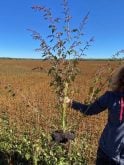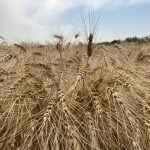Manitoba farmers should watch for three new annual weeds, says Bruce Murray, a weed specialist with Manitoba Agriculture, Food and Rural Initiatives.
The Eastern black nightshade, hairy nightshade and Lance-leaf sage (mint weed) are “not ‘end-of-the-world’-type weeds,” just relatively new to Manitoba, Murray told farmers here Jan. 21 during Ag Days.
“I think we’re going to see more and more of the nightshades and the mint weed. For whatever reason they are coming in.”
Read Also

Canadian hemp stable, but stuck on growth
Canada’s hemp industry hopes hybrid varieties, better yields, clearer regulations and new markets can help the crop break past its ceiling and get Canadian farmers planting more hemp acres.
Murray suspects they’re moving in from North Dakota where they are more prevalent.
“My gut feeling is it’s coming in with bean seed,” Murray said. “You grow an eastern crop or a southern crop, you’re going to get eastern or southern weeds. That’s just Mother Nature doing her thing.”
Murray also suspects they do better under minimum till.
There’s lots of confusion with various nightshade plants, but the Eastern black nightshade produces black berries, which contain the plant’s seeds. The hairy nightshade plant is hairy and it produces green berries. Both plants’ berries are similar in size to a soybean, making it hard to separate the two.
The berries are gooey inside and if damaged during harvest can discolour (tag) soybeans.
Both Eastern black nightshade and hairy nightshade have a distinctive potato-or tomato-type flower. Potatoes and tomatoes are also in the nightshade family.
Besides showing up in edible bean and soybean fields, these two
weeds are popping up in potatoes. That’s troublesome, Murray said, because it’s impossible right now to control a nightshade weed in a nightshade crop.” Potato growers need to start planning their rotations,” he said.
As its name implies, the Lance-leaf sage has long, narrow leaves. One of the easiest ways to identify it is its unique trapezoid-shaped cotyledon, Murray said.
“It’s a weird-looking thing.”
The plant has opposite leaves and square stems, which feel hairy and coarse like the stem of a sunflower.
“When you crush the leaves they are very pleasant smelling, just like mint gum,” Murray said.
A wide range of herbicides effectively controls all three weeds, Murray said. North Dakota’s online weed guide has more information.
Many of the same herbicides used to control the weeds in the United States are registered here, but because the three weeds are relatively rare here, might not be listed on the Canadian label. However, so long as the herbicide is registered in Canada for a specific crop it’s safe to use.














